
Porter class destroyers (1935)
 USN Flotilla Leader Destroyers (1933-59):
USN Flotilla Leader Destroyers (1933-59):
Porter, Selfridge, McDougal, Winslow, Phelps, Clark, Moffett, Balch
The first interwar Flotilla Leaders
Second step of the renewal of the US Destroyer force in the interwar, started with the Farragut class, the Porters were eight 1,850-ton large destroyers authorized by Congress on 26 April 1916 with funding delayed considerably. The tonnage limit followed the London Naval Treaty, with 13 ships of this size, that will be met by both the Porter and the later Somers class. The first four were laid down in 1933 at Camden NyD in New Jersey and the last four in 1934, at Bethlehem Steel Corp. Quincy, Massachusetts. Commissioned in 1936 they were seen as an answer to the “special type” of Fubuki-class destroyers of the Imperial Japanese Navy but answered to the flotilla leader type. Given their heavy armament they saw heavy action in WW2, notably in the Pacific, but soon proved difficult to upgrade due to metacentric height/stability issues. Only USS Porter was sunk, in the Battle of the Santa Cruz Islands (26 October 1942).
Design Development
Congress blocks early interwar proposals
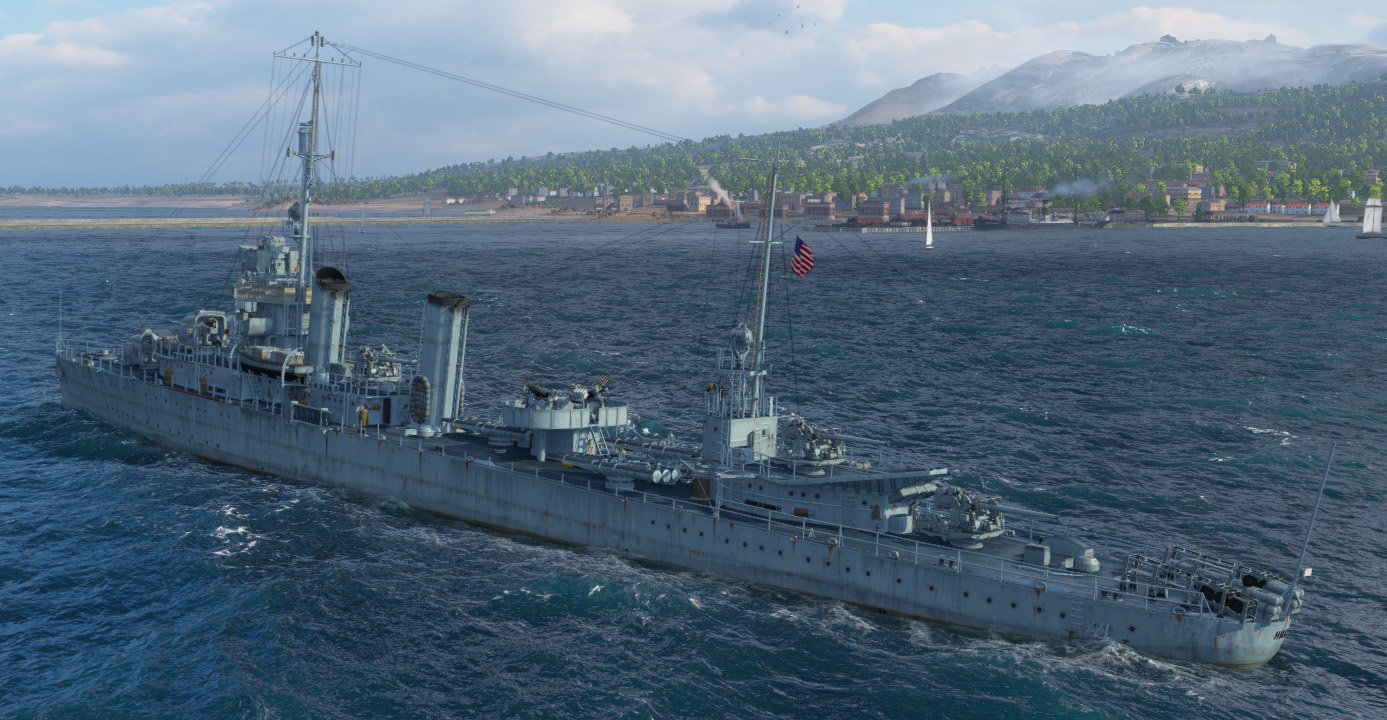
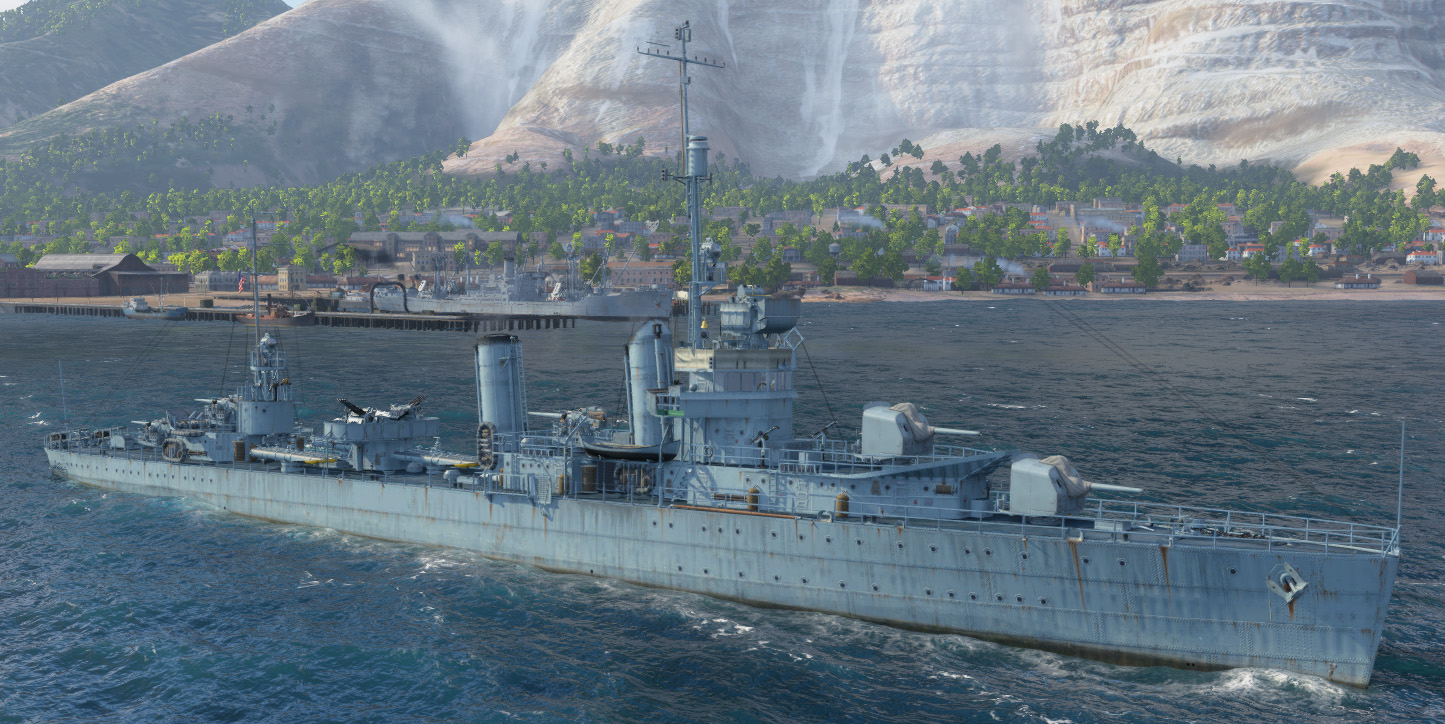
WoWs rendition of the 1919 destroyer leader project (“USS Hill”).
A Large destroyer leader type had been under active consideration since 1918, looking at the Royal Navy’s own experimentations, with the General Board recommending construction of five of them. This was pushed forward as the Navy, betting everything on dreadnoughts, lacked modern light cruisers, ordering in a hurry the ten Omaha-class. Having an immense quantity of Wickes and Clemson-class fleet destroyers also prevented the Congress to agreed on building flotilla leaders.
The General Board still wanted a leader to be given the new higher pressure/temperature steam propulsion turbines that were also to be adopted on the Farragut-class destroyers for extra range. Then came the London Naval Treaty. It showed that the Washington destroy standard was already made obsolete by the large French destroyers, as non-signatory of the treaty. There were recommendations following these, also some influence from the Geneva proposals for destroyers. A consensus fell to the Destroyer Leader being limited to 1,850 tons, and this was eventually included in the 1930 London treaty.
London Treaty Provisions
As per the treaty’s exact terms defining destoryers:
“Surface vessels of war the standard displacement of which does not exceed 1,850 tons (1,880 metric tons), and with a gun not above 5.1 inch (130 mm) caliber.”
Thus, the USN was globally allowed 150,000 tons (Britain 150,000, Japan 100,450). But the treaty also precised:
“not more than sixteen percent… shall be employed in vessels of over 1,500 tons (1,524 metric tons) standard displacement”
Hence the final counto of 13 flotilla leaders with a margin of fifty tons, for a 1,850-tonner. That’s what the naval staff started with for its flotilla leader project.
Still, there was debate regarding the realism of such displacement for a leader. In WWI indeed, it’s light cruisers (typical 1912-12 scout cruisers) or very heavy flotilla leaders (like the Italian Mirabello, Leone ect.) that led these flotillas, and they were all way above that tonnage.
And so, discussions went on back and forth between the admirakty and the Bureau of Construction & Repair (BuC&R) on torpedo armament, gun armamet, powerplant configuration and speed. It was soon realized that combining the firepower of a light cruiser to the 1850 tonnes hull was not going to cut it, if not for drastic construction mesures. In the end, at least the powerplant was settled as a repeat of the Farragut class machinery and more power. Armament was fixed to eight guns in four twin turrets, something unprecedented, and the guns were the brand new 5-in/38 types, fast-firing and potentially dual purpose. As for torpedoes, due to size issues, two side banks and one axial were chosen as a configuration.
The final design, like for the Mahan class was prepared by by Gibbs & Cox from NyC. It was validated in 1934.
Design of the Porter class
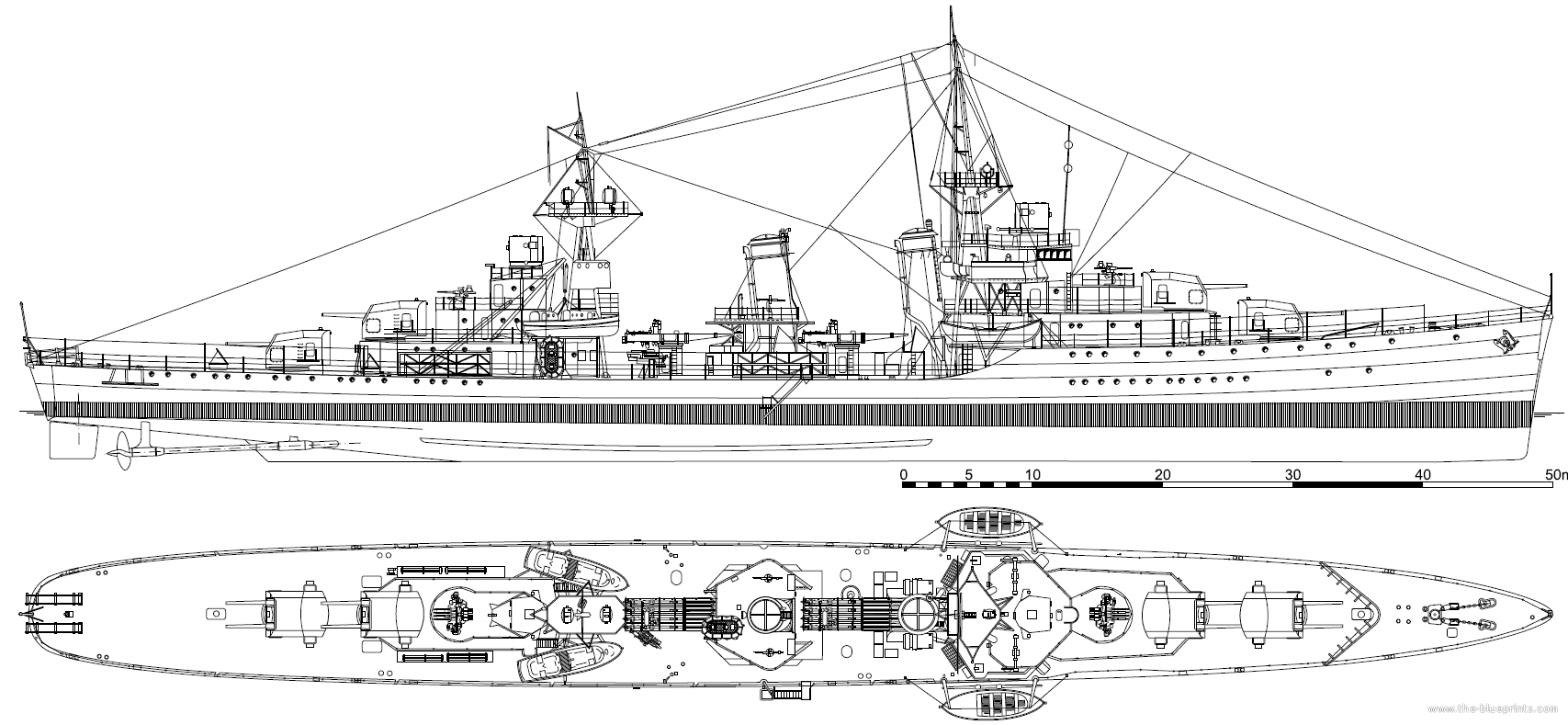
The Porter class in 1937-40. They looked very tall and top-heavy.
The final design was impressive for destroyers. These shared tripod mainmasts, after superstructure, superfiring 5-inch twin mounts forward and aft and therefore liked like mini-cruisers. The main issue was to pack all this on the tiny hull, yet still longer (381 feets oa – 732 waterline) and larger (36’6″) compared to the Farraguts (341’3″ and 34’2″ respectively). They had the same aft deck freeeboard but slightly higher forecastle as engineers feared she would “plough” heavily in foul weather. Both the general hull lines, bow shape, flare and stern shapes, were the same as the Farragut class essentially, also the Mahan class.
The big difference between the Farragut/Mahan and these, though, were these impressive superstructure. The bridge stand taller, alhough having the same shape, still two raked, unequal shape funnels, and extensive superstructure fore and aft. They were there to support and space-consuming configuration of forward and aft superfing turrets, something unheard of on a destroyer so far. Only Britain will venture there in 1936 with its Tribal class and the French already in 1935 when laying down their Mogador class, far more heavier than the Porters at 4,018 t (3,955 long tons) deeply loaded.
Needless to say also a 1,850 tons standard design was comparable to the Fubuki class, but not the 1937 Kagero or Asashio class (2,000-2,370 tons) which were standard, not leaders. The IJN will never venture into “leaders” but in WW2 for the first time proceeded with a “super-destroyer” design more intended for AA escort, the 1943 (2,701/3,700 t) Akizuki class.
Thus, when completed in 1936, there was nothing coming close in terms of armament on such a small package. They could have been considered the best “treaty flotilla leaders”, if not for obvious stability issues. Metacentric hight was above average, and despite weight-savings they would be hopelessesly top-heavy.
Construction
Only four of these destroyers were initially funded for FY 1934. In May 1933, President Franklin D. Roosevelt signed the National Industrial Recovery Act (NIRA), doubling this order to eight Porters (along with sixteen Mahans, four cruisers and the two Yorktown class carriers) in the wake of a state effort to reduced unemployment after the great depression.
The two batches were built respectively at New York Shipbuilding (DD-356-59) and Fore River Shipbuilding (Quincy Massachusetts) for DD-560-563.
They were ordered in 1933, laid down in 18 December 1933 (New York) and 2 January 1934 (Fore River), with the exception of USS Balch, on 16 May 1934. They were launched in 1935 for the most, USS Phelps, despite being laid down later than Porter, was launched in July, versus December for Porter. They were completed in 1936 August to December (Phelps was first) and Winslow in February 1937.
The class still bears the name of the first pennant in line, DD-356, hence USS Porter.
Hull and general design
The most striking aspect of the design were these tripod masts, alongside the impressive superstructures. They carried tall masts and platforms for projectors. Combined with their superfiring twon turrets, they really contributed to a tall and compressed allure, really unique in destroyer design. They looked tall and impressive, really fit for a flotilla leader. It seems their metacentric height ans duppose instability was not an issue at first. Captains knew they would be not pushed hard over or in heavy weather without care. Their masts in particuar were a source of heavy drag especially dangerous for broadside gusts. There never has been reasons to doubt their handling however, which was generally good, but indeed their roll was slow and deep and they “ploughed” a lot as expected, their saving grace being a tall prow and forecastle, preserving seakeeping.
As the original documentation 1 shows, the hull was built of 186 frames, with no transverse framing, with frame spacing of 2 feet. They measured between perpendicular 372 feets, and 381 feets and one half inch overall, with the typical fine entry with limited flare and broad aft section, the largest beam reached aft out the amidship section. Model breadth at D.W.L. reached 36 feets 6 inches. The raked funnels culminated at 46 feets and 5 inches (forward) and 44 feets 5 inches for the aft one. The pilot house towered at 43 feets 6 inches above the waterline, and the forward 1.1 in quad mount at 34 feets.
At main deck, this was 21 inches, a freeboard at the bow 23 ftees 8 inches, and at the stern with had a rounded deck and angular downwards slopind back face (“semi-transom”), was just 12 feets and 6 inches and a half. Official documentation gave them a 1,850 tonnes displacement standard as planned, and 2,131 tonnes fully loaded, which was still moderate for their role and armament.
They propeller shaft were inclined down aft at 0.5922 inches per feet. The rudder was 101 squares feet in surface (“projected area”).
The documentation reveals interesting points about the measures taken on stability:
It is specified calculation of ballasting were made based on “Condition II”, a state in which the ship was experiencing roll with fuel, water, ammunition and stores were expended. It was given the instruction to use fuel and water from the lower tanks last. There was a chart mentioning a “Minimum Safe Operational Displacement” which was 2,100 tonnes, with a mean draft of 11 feets 2-1/2 inches. If oil tanks were near-empty it was specified that water ballast should be taken onboard in place. The case of two of the Farragut class famously lost in the Typhoon Cobra were caught while refuelling, their tanks empty and captains not aware of this measures or not ordering it in time. Fortunately this never happened to any Porter class, which strangely gained a somewhat better reputation.
Powerplant
The Porters reused the same propulsion as the Farraguts. There was no time to look after something else.
Boilers
They used for the first time (but like the Farraguts) superheated steam coming at 400 psi (2,800 kPa) pressure and 645 °F (341 °C). Due to the larger displacement, the powerplant was scaled up. Larger Babcock and Wilcox boilers, more powerful and torquy turbines with horsepower increased from 42,800 shaft horsepower (31,900 kW) to 50,000 shaft horsepower (37,000 kW).
In the end this procured the same 37 knots (69 km/h; 43 mph) with all the added weight and drag. Superheated steam improved fuel efficiency, and the four boilers in addition had economizers, preheating incoming feedwater.
Turbines
The steam turbines came from New York Shipbuilding for the first batch and (presumably) GE for the other. They had single reduction gearing, no cruising turbines however. Called implulse & reaction type they had 11 high pressure stages and 17 low pressure ones. On th shaft, this gave 400 rpm at a combined 3,300 HP and 2,300 LP).
Auxiliary Power
In addition, they carried two generators from GE coupled with two Cooper Bessemer Diesels engines. The latter were rated for 167.5 hp, of a high compression 4-cycle V-8 type, 1200 rpm,while the electric generators were of the 7-1/2 KW exciter type rated at 450 volts AC current, or 70 KW.
The turbogenerators from General Electric were DN-5 horizontal implulse 5 stages, Type ATB-FR 7565 Revolving field 6 pole, separatedly excited from overhung exciter, 450 volts 3 phased 200 Kw AC current. The DC exciter was a 5 KW 120 Volts 4 Pole type.
Propellers
Bronze type, true screw with solid (cast) manganese bronze by New York shipbuilding, three bladed with a diameter of 11 feet, variable pitch and driven by shafts which were 15 inche sin diameter.
Load and Range
Official doc. shows they carried 235 tonnes of fuel oil in normal conditions, 635.33 tons max with a 95% full load. They had portable water tank which also acted as ballasts, 35.46 tonnes, a reserve of feed water, 84.4 tons and two diesel oil tanks for the generators, 24.25 tons each.
For the range, the ships nominally can reach 6,380 nautical miles (11,820 km; 7,340 mi) at 12 knots (22 km/h; 14 mph) and full load.
Protection
Due to weight issue, only the hull was strenghtened. The suprestructures were built with only standard mild steel plating, about 0.1 or 28 mm thick.
The Mark 22 Mod 0 turret was protected by 0.125 in (0.32 cm) of steel all-around. This was weak, and again to save weight, protecting only against shell splinters to some extent. To compare, later DP mounts such as the Mark 28 Mod 3 had a 2.5 in (6.35 cm) front plating to face strafing fire, destroyer shells and all splinters.
Armament
There were extensive discussions about the armament, the 5-inch (127 mm)/25 caliber anti-aircraft (AA) gun being favored as being easy to work with and train, perfect for a destroyer. The other candidate was the 5-inch/51 caliber surface gun type, much powerful with longer range, but slower to reload and useless against aviation. The discussion made more interesting as the 5-inch/38 caliber dual purpose gun became available in the early 1930s and the Ordnance Department favored it rather strongly. The 5-inch/38 caliber gun was simply a 5-inch/25 caliber gun with the same shells and longer barrel, but significantly increased range against both air and surface targets, also the first US successful dual-purpose gun.
In the end, the choice fell on the 5-10/38 Mark 12.
Main
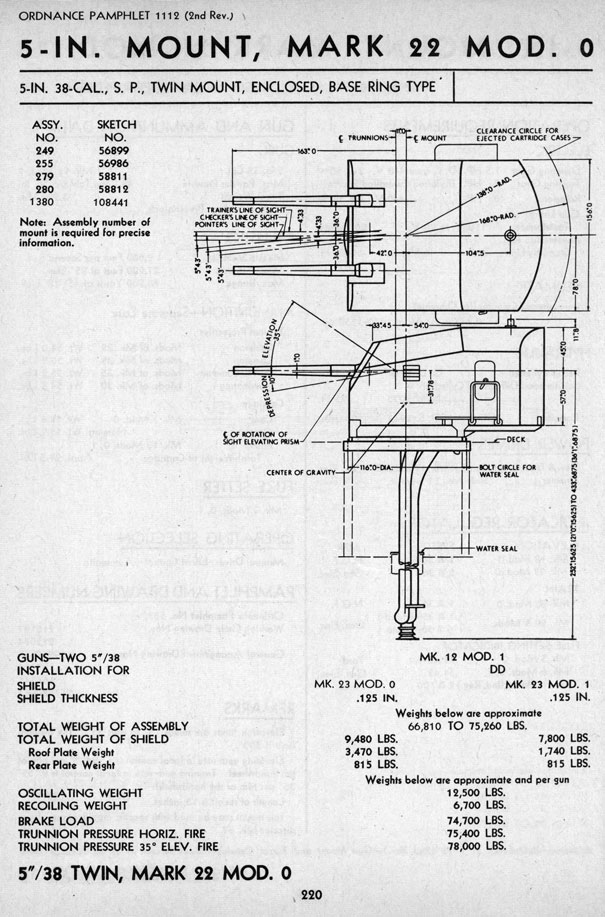
Mark 12 gun on Mark 22 mount and turret, sketch from OP-1112. Src: HNSA.
As put it by navweaps.com and in many other publications, the 5-inches 38 caliber revealed itself as the finest Dual Purpose gun of World War II. If proof was needed, it was still in service in countless ships in 1990.
It is also largely credited to down most of the Japanese aviation in WW2, perhaps more than the 40 and 20mm combined. It became the go-to gun on destroyers, cruisers, battleships and aircraft carriers in WW2, providing an intermediate “FLAK” bubble that had no equivalent worldwide and made all Japanese air attacks from 1943 doomed to failure, even versus Kamikaze. Needless to say, the use of fuses and better fire control systems (and radars in 1944) were part of the package and immensely contributed to this success.
The 5-in caliber was not unknown in US naval ordnance, it has been the staple of the fleet since WWI but the interwar saw a boiling of new ideas about rapid-fire and dual purpose.
However the Mark 22 adopted for the Flotilla leaders was unique in many ways.
The Porter class was originally built with eight Mk 12 guns, in four Mark 22 single purpose (surface action only) twin enclosed mounts. The single purpose mounts were adopted to save weight, as it made the gun cradle simpler and the turret more compact.
The Mark 22 was shared by the Porter and Somers. Thus, 52 of such turrets were manufactured for the thirteen destroyer leaders, and a first batch of 104 barrels, followed by another as spares.
These turrets and mounts weighted 75,250 lbs. or 34,133 tons. The gun mounts elevated from -10 to +35 degrees at a rate of 11.6 degrees per second.
The arc of fire (traverse) depending of the position was between 290 and 330 degrees. Upper mounts had the clearest arc. They train at a rate of 14.7 degrees per second, which was slow, but consistent with an antiship role. For comparison the DP Mark 30 with Ford controls traversed to 34 degrees per second… The gun recoil was 15 in (38 cm).
These Mark 22 mountings used a 15 hp training motor and 5 hp elevating motor.
The Mark 22 also was different from the DP mounts in what the guns were separated by 72 inches (183 cm) versus 84 inches (213 cm) for the DP mounts. This made them more susceptible to interference.
There is not enough data however to indicate a loss of accuracy.
The shells used were probably the early AAC Mark 34 Mod 10 – 55.18 lbs. (25.0 kg) for 20.75 in (52.7 cm) in lenght. They used a 7.25 lbs. (3.3 kg) Explosive D or Composition A bursting charge, Brass cartridge 127 x 679 mm, 12.31 lbs. (5.58 kg), for a muzzle velocity of around 2,600 fps (792 mps), with an approx. barrel life of 4,600 rounds. Circa 300 were carried for each gun, thus 600 shells per mount, 2,400 per ship. At 35° range was 16,739 yards (15,298 m), but best penetration power was at 4,000 yards (3,660 m) where the AP shell can penetrate 5-in (127 mm) of hardened steel plating.
Mark 35 SP Fire Control Directors
Completely integral to these turrets and unique also to the class, were the Mark 35 Fire Directors, installed on top of the pilot house, and after deckhouse, close to the tripod masts. These were heavy fire controls more related to cruisers thand destroyers, and reinforcing the image of “mini-cruisers” of these very unique destroyers. To compare, the Farragut, Mahan and successors had a unique Mark 33 director. In fact, after reconstruction, they lost both Mark 35 to save weight, replaced by a unique Mark 37 or 38 fire control system.
Information is scarce about these rare Directors to say the least. I hope to cover them with the Somers class.
QCA sonar
Early type, spherical, underwater. Manufactured by CMB. 24 cycles frequenty, M/S spherical projector, 400 Watts, electric hoist and train.
Radars
Only installed in 1942-43, they received a set of three radars. One was fitted on top of the pole mast, another was used for rangefinding on top of the forward Fire Control Tower, plus an antenna aft. There were the follwing standards:
SC Radar: 220 KW Air/Surface Search, VHF band 60 Hz Bwt 10–25° Pwdt 4–5 μs Range 48–120 km (30–75 mi) @90–180 m (98–197 yd) (Top mast)
SG Radar: 50 KW Surface Searc. Frq 3 GHz PRF 775/800/825, Bmwdt 5.6°/15°, Pwdt 1.3–2 μs RPM 4/8/12, Range 15 nmi @200 yd
Mk 3 radar: Beam width 9°, antenna with sum dipoles length 4 wave lengths. Medium Wave Fire Control for Main Battery. Compatible with the Mark 35 director.
Mk 12.22 radar: Installed on USS Selfridge in replacement for the Mark.3. Medium Wave Fire Control for Dual Purpose Batteries, goes with the Mark 37 FC Director.
Secondary
Anti-aircraft protection was provided by two quadruple 1.1-inch (28 mm) mounts. in the 1930s this was considered sufficient. The infamous “Chicago Piano” were the staple of USN AA armament in the later interwar and prior to 1941. They were the fruit of many researches and development over the ideal medium AA gun in the early interwar, which led to the adoption of a 1.1 inches (28 mm) caliber, to be completed by the ubiquitous 0.5 in Browning heavy machine gun, common in the fleet. It was developed from 1928.
What was unique here, is that the Porter and Somers were large enough to carry two quadruple mounts, unlike the Farraguts and follows-up, which had single mounts.
They were located on platforms, one behind N°2 turret forward, at the foot of the bridge, superfiring above the upper turret and resulting in a tall superstructure overall. The second was located the same, but after the quarterdeck structure.
The 1.1″/75 was not a bad gun per se. When production started in 1934, when the Porters were just started, the cyclic rate was 140 rpm, and rose to 150 after improvements, but using 60 rounds clip magazines. There was a 2,700 ft/s (820 m/s) muzzle velocity and effective range of 7,000 yd (6,400 m). Completely obsolete in 1941 they were replace when possible on a one-to one basis by 40 mm Bofors. But weight savings had them removed entirely. AA was also completed by 20 mm Oerlikon guns which took less space.
Torpedoes
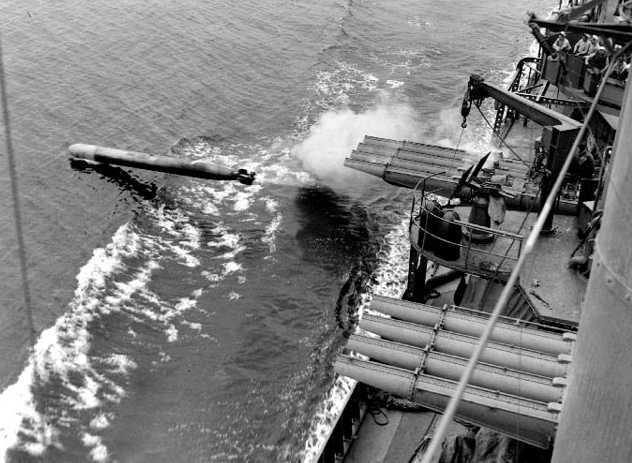
USS Dunlap firing its Mark 15 torpedoes.
The Porters had the same eight 21-inch (533 mm) torpedo tubes as the Farraguts. They had reloads for both so 16 torpedoes in all. These eight torpedo reloads were placed in special containers abeam the after stack, but reloading underway was a complicated and dangerous operation. The class was initially planned to carry Mark 11/12 torpedoes, but replaced later by the Mark 15 from 1938. These quad mounts were both located in the axis, high-up above the deck, fire and aft of N°2 funnel.
The Mark 15 torpedo was introduced in 1935. The Mod 0 weighted 3,438 lbs., and measured 22 ft 7 in (6.883 m). It had a negative buoyancy of 1,260 lbs. (572 kg), and carried a 494 lbs. (224 kg) TNT warhead at three settings: 6/10/15,0000 yards at 45/33.5/26.5 knots. They were powered by a Wet-Heater steam turbine, guided by a Mark 12 Mod 3 gyro.
Design Issues and upgrades
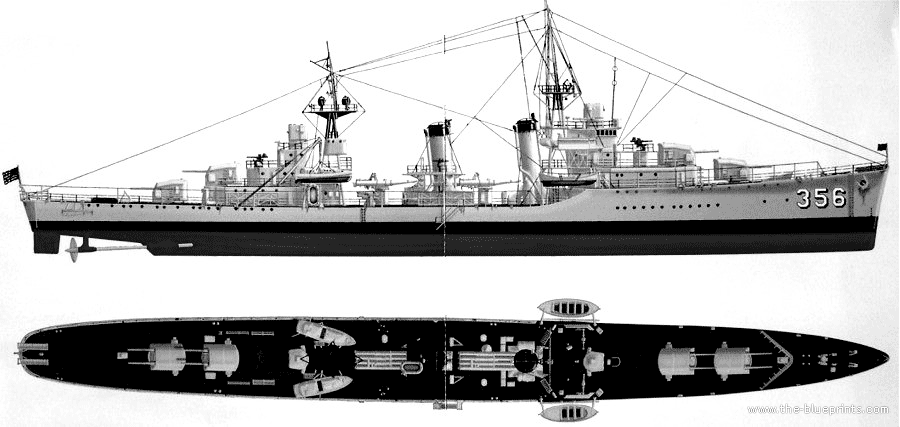
USS Porter as built, 1936. Common peacetime light grey livery (measure) with dark blue-grey decks (measure) and large identification numbers, white on black BG. src pinterest.
The “gold platers”, setting a new standard
The ships were also known as the “gold platers”. If they introduced all the features of the previous Farraguts, they also were latter re-equipped with the brand new 5-inch/38-cal dual purpose, later coupled with an increasingly better effective fire control system. When entering service both the Porters and Farraguts were criticized for their “over-lavish facilities” by old-timer accustomed to the Wickes/Clemsons. They thus started to refer to them as “gold platers.” The Porters were a confirmation of this standard, with six more classes (Farragut to Sims) class and the two thirteen destroyer leaders of the Porter and Somers classes. They still formed a really important step in the direction of wartime Fletcher class in many ways. Most bases were already setup by the Farragut and Porter.
Both both also shown what was possible and not desirable based on a strictly limited tonnage. The USN already had issues with their standard fleet destroyer (The Farraguts) and actually two were lost during Typhoon Cobra in 1945 while caught refuelling, their tanks empty. The Porter class were even more problematic: Their tall superstructures and heavy armament, based on a smallest tonnage possible (which was unique to US treaty calculations) were even worse, dictating comprehensive refits soon into the war, which were limited on the Farraguts. It soon appeared that by trying to answer the Fubuki, which only had two turrets, the Porters’s choice of four twin turrets mays sound only good on paper. Being already top-heavy while in service while lacking adequate AA without much room for additions (and serious stability issues), the first move was naturally to light them out.
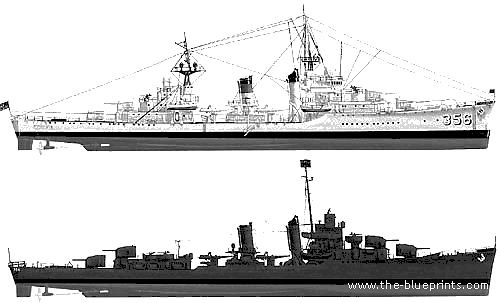
Design evolution: USS Porter in 1941 and another ship in 1944
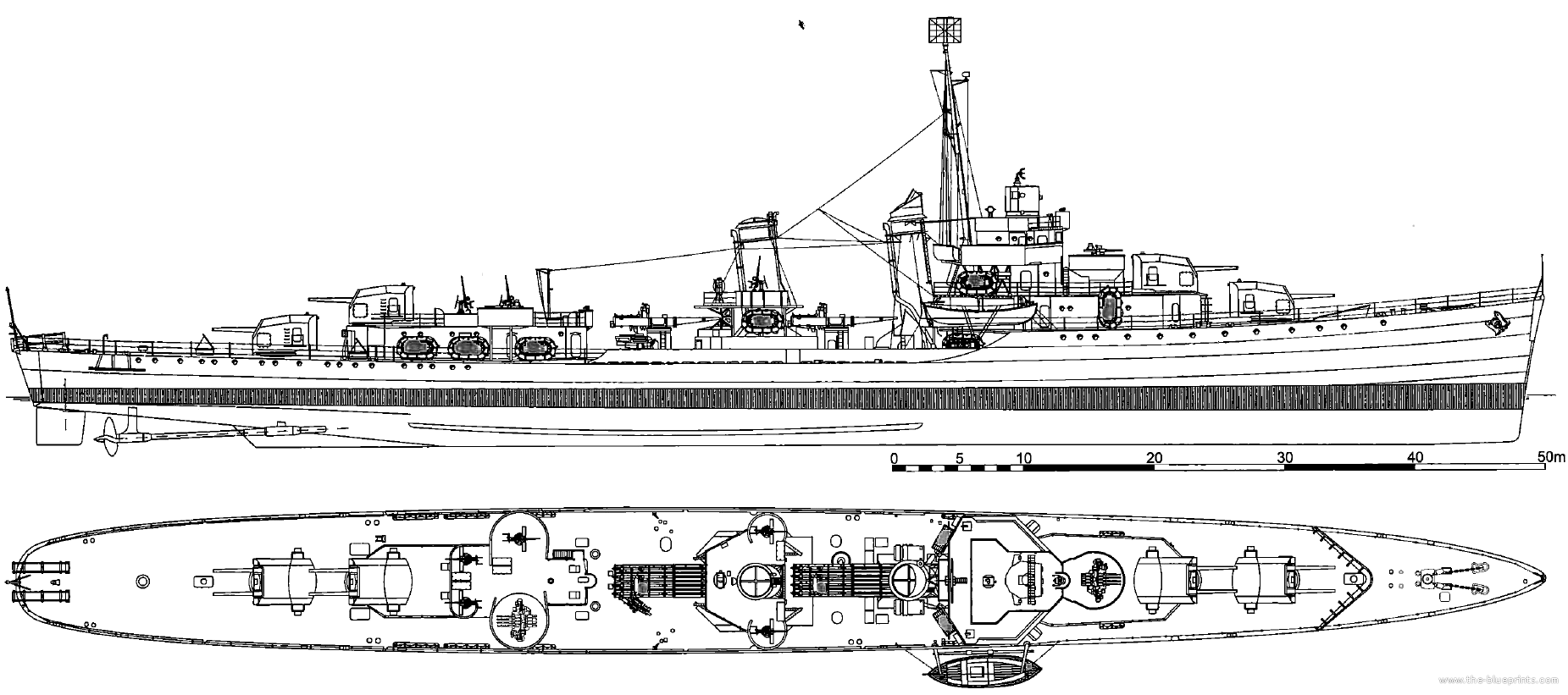
USS Porter in 1942. Note the early reconstruction results: Single pole mast, razed aft structure, single Mark 33 director, N°3 Mark 22 turret removed.
Reconstructions and Modernizations
In World War II dual purpose twin mounts were installed in place of their original turrets. Their 1.1-in “chicago Piano” Mark 52 were replaced in time by twin 40 mm Bofors and lighter 20 mm Oerlikons. The thord turret were alsp replaced by a Mark 53 twin Bofors. Engineers tried to add single 40 mm guns amidships, closer to the center of gravity, sacrificing the arc of fire, as extra 20 mm guns. Four K-gun depth charge throwers (DCT) were also added soon, in 1941, in addition to their racks for better ASW capabilities. Radars were also added systematically in 1942-43 when possible.
A few were rebuilt and DD-357, DD-359, DD-360 in 1944 had their torpedo tubes, K-guns, one ASW DC rack removed and replaced by extra AA, reaching sixteen 40 mm (3×4, 2×2) plus four (2×2) 20mm Oerlikon. Here is the detailed history of these modifications:
Mid-1941: And up to early 1942, they all received an extra twin cal.50/90 Browning M1920, but had their spare torpedoes removed in order to have later three single 20mm/70 Mk 4 Oerlikon guns added.
1942-1943: All but USS Porter (sunk) received a new radar suite, the SC, SG, and Mk 3 radars
October-December1943: The two quad 28mm/75 are removed and replaced by three twin 40mm/56 Mk 1.2 Bofors and three extra 20mm/70 Mk 4 Oerlikon AA.
1943-44 For McDougal, Winslow, Phelps, Clark, Moffett, Balch their No 3 main turret is removed and replaced by an extra quad 40mm/56 Mk 1.2, and they gained 4 depht Charge Throwers in addition to their two racks (in total 48 DC).
From late 1944 to early 1945: USS Selfridge, which lost her bow in action was completely rebuilt, having her four twin 127/38 SP removed as well as a twin 40mm/56 Bofors and Mk 3 radar. Instead she obtained two twin 127mm/38 Mk 12 DP, a single 127mm/38 Mk 12 DP (Fletcher standard) aft in N°3 position, and a quad 40mm/56 Mk 1.2 in N°2 position, plus the same two DCR and four DCT, 48 DC, but also a Mk 12.22 radar. In addition her superstructure was considerably changed. Heir tall forward bridge was cut down to the minimum, with an enclosed pilot house with portholes. On top of it was located the new Mark 37 Fire Control (she had two Mark 35 originally). She became the prototype for further reconstructions, radical but deemed quite successful and also ported later on the Somers class. USS McDougal, Winslow and Phelps quickly followed suite.
August 1945: USS Selfridge, Winslow and Phelps had six 20mm/70 Oerlikon removed as well as their two 533mm TT banks and two DCT, one DCR removed plus 22 DC left. This was for the nenefit of adding an extra quad 40mm/56 Mk 1.2 Bofors and two twin 20mm/70 Mk 4 Oerlikon guns on a platform, with the displacement increasing to 2,154 tons standard and 2,857 tons fully loaded.
Postwar (1946):
In January 1946, DD360 (USS Phelps) had two twin 127/38 Mk 38 and a single 127mm/38 Mk 30 installed and three quad 40mm/60 Mk 2, two twin 40mm/60 Mk 1, two twin 20mm/70 Mk 24, 2 DCT, 1 DCR left as well as their SC, SG, Mk 12.22 radars and QCA sonar. Only changed for DD362 (USS Moffett) was their three twin 127mm/38 Mk 22, single quad 40mm/60 Mk 2, three twin 40mm/60 Mk 1, six single 20mm/70 Mk 10, keeping the TTs, full DCT and DCR and older Mk 3 radar. That was before decommission.
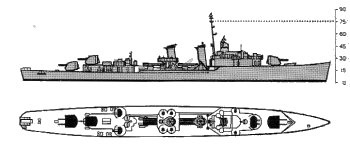
ONI 1944 reconstruction schematics. The ultimate transformation of the class: Two twin DP turrets, 40 mm and 20mm guns, razed forward bridge
Armament-wise, there is a lot to say. Most of the destroyers keeping their Mk.22 mountings lost their turret No. 3 to save weight allowing to add extra AA, and ultimately they were removed entirely for two twin Mark 38 DP and a single single Mark 30 DP on those most rebuilt.
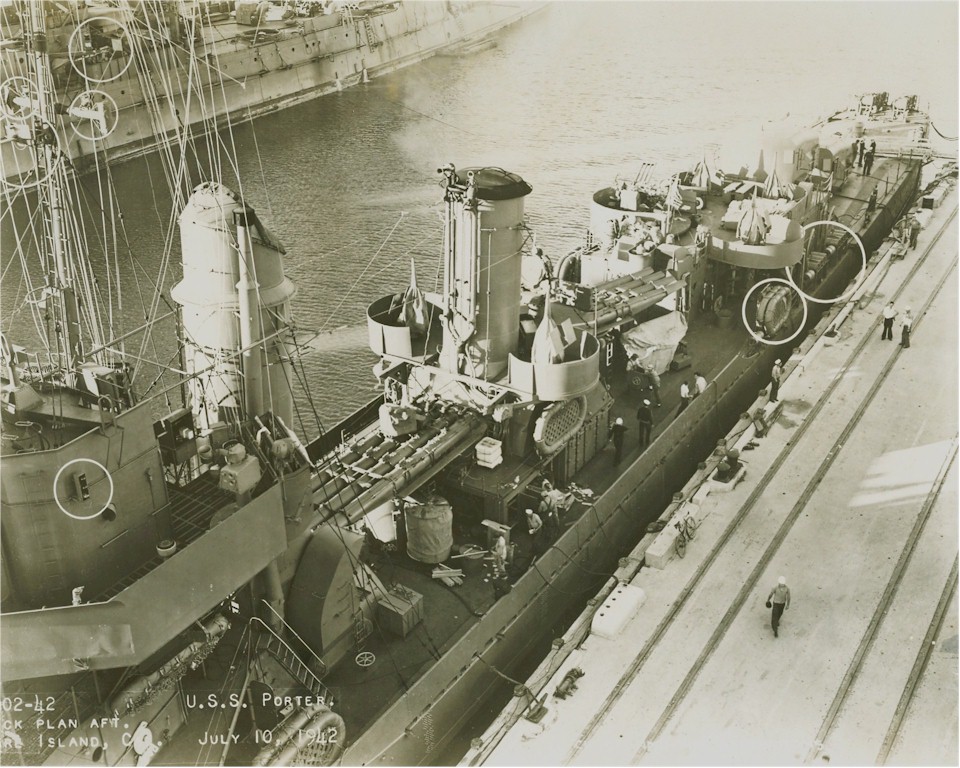
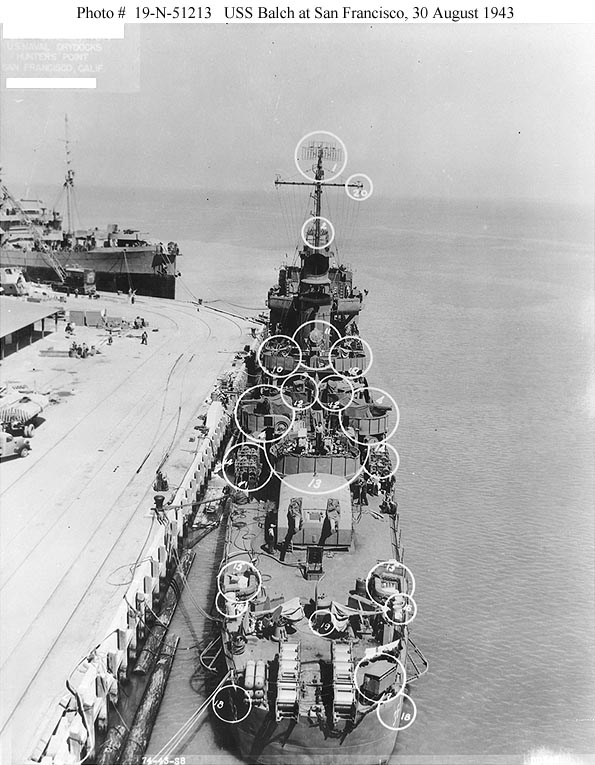
USS Porter (top) and Balch (bottom) reconstruction details at Mare Island and San Francisco – ONI
General Assessment
Design-wise, it’s clear that plasing all that armament and superstructures over a 1,850 tons hull was not going to cut it. The engineers followed very strict guidelines, but produced a design that has little room for additions, hence long term upgrades. The high metacentric values due to massive-top weight were to compare with the Pensacola class cruisers. They almost looked like destroyer versions of the latter. Sticking to the treaty limits in that case was to be very problematic when WW2 started. They all needed AA upgrades and the opnly way to do it was by massive reconstructions and deletions as shown above. Some even went so far as to completely change most ship’s caracteritics, but cure in the end their issues for good. USS Selfridge is a good example of that, going down to a single TT bank, only two twin 5-in/38 DP, single pole mast supporting a radar, razed bridge, eliminated rear structure, and massive AA upgrades.
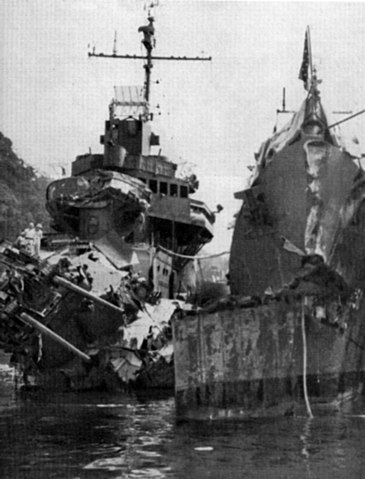 Career-wise they all but one survived the war: McDougal, Winslow, and Moffett were part of the escort for the Newfoundland’s August 1941 Roosevelt-Churchill conference (Placentia Bay, Argentia) for the Atlantic Charter. USS Selfridge and Phelps fought at Pearl Harbor on 7 December 1941. Some did convoy escort in the Battle of the Atlantic where USS Moffett assisted the sinking of U-128 and U-604.
Career-wise they all but one survived the war: McDougal, Winslow, and Moffett were part of the escort for the Newfoundland’s August 1941 Roosevelt-Churchill conference (Placentia Bay, Argentia) for the Atlantic Charter. USS Selfridge and Phelps fought at Pearl Harbor on 7 December 1941. Some did convoy escort in the Battle of the Atlantic where USS Moffett assisted the sinking of U-128 and U-604.
However it’s in the Pacific they shone best: USS Phelps was at the Battle of the Coral Sea and the Battle of Midway as USS Balch, where both assisted USS Yorktown to the end. Others also took part in the Guadalcanal and the Marianas campaign, like the Battle of Vella Lavella. The lead ship, Porter, was the only one lost, at the Battle of the Santa Cruz Island.
By September 1944 they were all moved to the Atlantic. s on 26 October 1942. USS McDougal and Winslow became AG-126 and AG-127 in September 1945, testing a new anti-kamikaze tactic, reconvertied along the lines of the Gearing-class radar pickets. Only Winslow survived scrapping: She stayed as a training ship until 1950, only scrapped in 1959, despite talks of preserving her. He have indeed no destroyer of the 1930s generation surviving today. Turning ships into museums was not a thing in the 1950-60.
Gallery
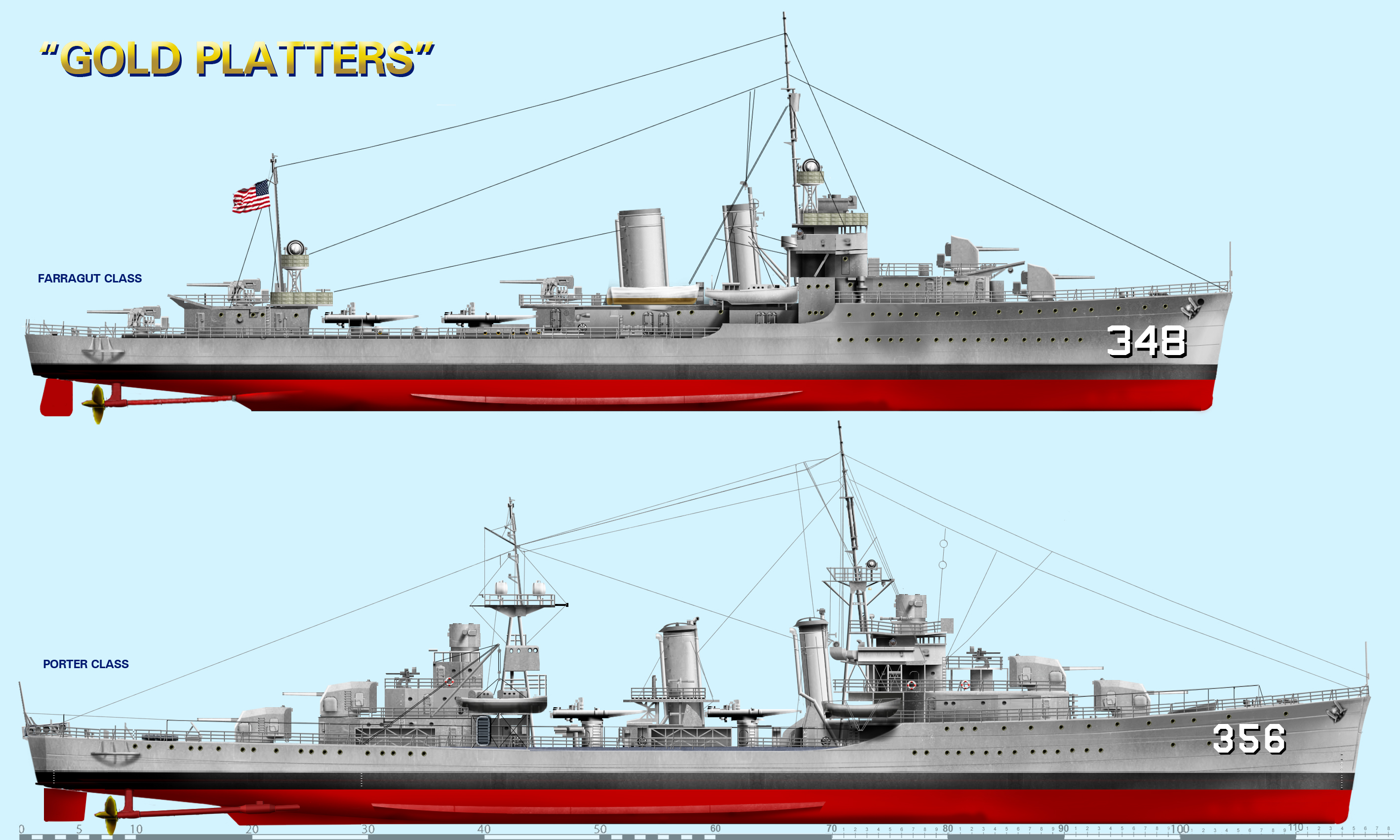
“Gold Platters”: comparison between the Farraguts standard destroyers and Porters flotilla leaders

USS Porter as built, 1937. Common peacetime Light Gray 5-L livery (no measure assigned) with dark blue-grey decks and large identification numbers, white on black BG.

USS Clarke in measure 1 Dark Gray System, neurrality patrols, Atlantic, late 1941. Same ship with added ASW racks aft and extra DCTs aft.

USS Porter in measure 21 Navy Blue System (Navy Blue 5-N Vertical surfacesn Deck Blue, 20-B for vertical ones), 1942. Note the early reconstruction results: Single pole mast with radar, razed aft structure, single Mark 37 director, 20mm AA added.
(to come) USS Selfridge after loosing her bow at the battle of Vella Lavella, as rebuilt in April 1944: The ultimate transformation of the class: Two twin Mark37 DP turrets, 40 mm and 20mm guns, razed forward bridge. Measure 32 design 22D: Wavy pattern of light grey and black. Decks like 3D.

USS Phelps in October 1944: Measure 32 Design 3D: Light Gray 5-L, Ocean Gray 5-O, Black and for horizontal surfaces Deck Blue, 20-B, Ocean Gray 5-O.
⚙ Porter class specifications |
|
| Displacement | 1,850 tons standard, 2,663 tons full load |
| Dimensions | 381 x 36 ft 2 in x 10 ft 5 in (116 x 11.02 x 3.18 m) |
| Propulsion | 2 shaft GS Turbines, 4 B&W boilers, 50,000 shaft horsepower (37,000 kW) |
| Speed | 37 knots (69 km/h; 43 mph) |
| Range | 6,380 nautical miles (11,820 km; 7,340 mi) at 12 kn (22 km/h; 14 mph) |
| Armament | 4×2 5-in/38 Mk22, 2×4 1.1-in/75 AA, 2x 0.5 in HMG, 2×4 21-in TTs |
| Armament (1942) | Same, twin 40mm, 6x 20mm AA, 2x DCT |
| Sensors | Two Mk35 GFCS (later single Mk35/37 GFCS, SC radar) |
| Crew | 13 officers, 193 enlisted peacetime and 290 wartime |
Read More
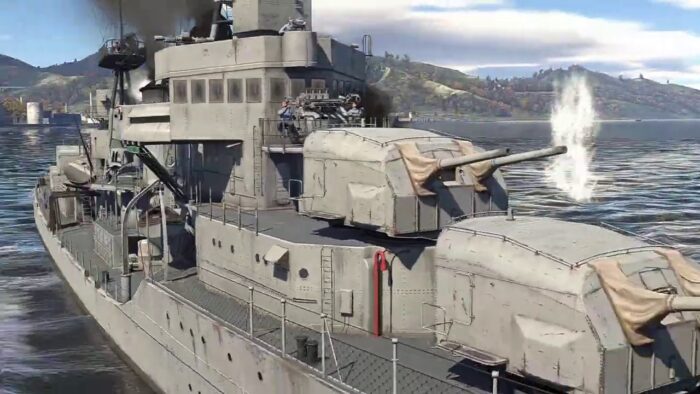
Video games rendition of the Porter class
Books
Bauer, K. Jack; Roberts, Stephen S. (1991). Register of Ships of the U.S. Navy, 1775-1990: Major Combatants. Greenwood Press.
Friedman, Norman (2004). US Destroyers: An Illustrated Design History (Revised ed.). NIP
Gardiner, Robert; Chesneau, Roger (1980). Conway’s All the World’s Fighting Ships 1922-1946.
Silverstone, Paul H. (1965). U.S. Warships of World War II. London: Ian Allan Ltd.
Public domain, Dictionary of American Naval Fighting Ships.
Links
1937 official documentation, Bureau of Ships
On destroyers.org
on navypedia.org
The 1850 tons on destroyerhistory.org
destroyerhistory.org/ the “gold platters”
Porter on navsource.org
Porter (iii) at hazegray.org
Navweaps USN interwar torpedoes
Navweaps 5-in/38 Mark 22
USS Phelps on laststandonzombieisland.com
Wiki
history.navy.mil: ONI operational-characteristics-of-radar-classified-by-tactical-application
List of Naval Radio, Radar, and Sonar Equipment Arranged by Navy Model Letters SHIPS 242A January 1945
Model Kits
USS Porter 1940, Yankee modelworks kits (resin and metal)
Neptunia kit and doc for the Porter class
Review Combrig kit 1/700
modelshipgallery.com
 USS Porter DD-356 (1935)
USS Porter DD-356 (1935)

USS Porter off Yorktown, Virginia, 19 April 1939.
After shakedown in waters off Northern Europe, Porter sailed to St. John’s, Newfoundland, as an escort for ceremonies linked to the coronation of King George VI and Queen Elizabeth in May 1937. She was in Washington Navy Yard in June–July 1937 for post-shakedown fixes. Reassigned to the Pacific Fleet, she sailed to San Francisco via the Panama Canal and started service on the west coast in August 1937, until 1939, participating the fleet problems and training in the water of Hawaii, but had her home port at San Diego. Until late 1941 her peactime routine went on, unlike destroyers of the est coast, deployed in more and more agressive neutrality patrols versus U-Boats.
On 5 December 1941, USS Porter was not at Pearl Harbor. She patrolled with cruisers and destroyers in Hawaiian waters, hoping to catch the fleet, but was reassighned to a convoy on 25 March 1942 for the west coast, with ships needed repairs. She operated from there Task Force 1 for 4 months and was back on Pearl Harbor in mid-August 1942. Apart exercizes and escort missions for home, she stayed in the vicinity of Hawaiian waters. On 16 October 1942 she was reassigned to TF 16 for an escort mission to the Solomon Islands.
It’s there she took part in the Battle of the Santa Cruz Islands:
On 26 October air attacks went on the IJN fleet posted northeast of Guadalcanal. USS Porter as an escort was suddenly struck by one or several torpedoes. It was enough to flood her engine room and stop her dead on her tracks. Listing, she was slowly sinking. The captain ordered to abandon ship, all were evacuated, and USS Shaw was ordered to scuttle her by firing torpedoes.
Modern authors are debating still on the nature of the torpedo attack. Author Eric Hammel suggested she was in the path of a spread of three torpedoes fired by IJN submarine I-21. Richard B. Frank states that Japanese records are blank on this, and it was more a random, errant torpedo from a ditching US Navy Grumman TBF Avenger. Whatever the origin, she was stricken on 2 November 1942 but still earning a single battle star for World War II service. She had thus the shortest career of all porters, being also the only one sunk in action.
 USS Selfridge DD-357 (1936)
USS Selfridge DD-357 (1936)
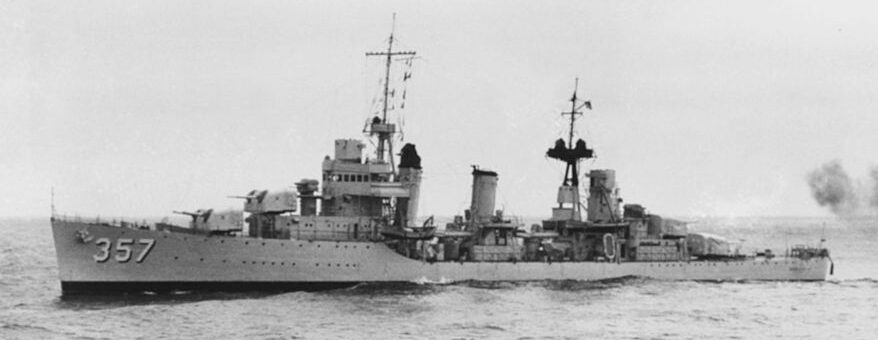
USS Selfridge was commissioned at Philadelphia NyD on 25 November 1936. Her shakedown cruise conducted her in the Mediterranean (January-February 1937) after which she had her first post-shakedown fixes on the east coast via the Caribbean in March 1937. April-August saw extensive post-shakedown overhaul and training exercises off Philadelphia. In September she was in the Presidential escort in Poughkeepsie, New York. By October, she proceeded vua Norfolk to Panama Canal, but went back to Norfolk for another Presidential escort in November and went to the west coast for good on 9 December 1937.
Based in Pearl Habor, with the Battle Force, she became flagship DesRon 4 on 13 December 1937, at first based in San Diego. She took part in fleet problems 1938, 1939, 1940 and various exercises until reassigned to Pearl Harbor. On 7 December 1941 USS Selfridge just went back from an escort tp Palmyra Island. She was moored at berth X-9 and 5 min. after the attack started her crews were already firing, inclusing the main guns at max elevation. Since part of her crew was missing, she gathered mixed crew from other ships and sailed off Oahu, trying to catch the Japanese.
She was screening Saratoga duing the attempted (and cancelled) reinforcement run to Wake Island. In January 1942, she remained attached to the Saratoga group until she was torpedoed 500 miles southwest of Oahu and was escorted back to Pearl Harbor. After training in Hawaiian waters on 20 January she took part in the Canton Island convoy run. While underway on the 30th, she spotted and charged an enemy submarine, depht charged with no result but probable damage.
On 9 February she escorted USS Saratoga to Bremerton (Washington) for permanent repairs. In March back in Hawaii with a convoy she escorted another to Canton. In April she had Marine Corps personnel and mail on board to Palmyra and Christmas islands. She met another convoy at Bora Bora (Society Islands) bound for Samoa-Tonga. On 21 May 1942, she was en route for the New Hebrides and Australia and proceeded there to coastal escort until attached to TF 44. By mid-July she took part in a preparatory exercize in the Fijis, for Operation Watchtower.
On 7 August 1942, in the former TF 44, now TG 62.6, she escorted transports bound for Guadalcanal and at 06:20 she opened fire on a small IJN gasoline in Tulagi harbor. She covered the landings and at 13:20, repelled an air attack. The following day she screened the transports and on the 9th, picked up survivors of the disastrous Battle of Savo Island. Together wth USS Ellet, she finished off HMAS Canberra and proceeded to Noumea, New Caledonia.
For the remainder of August she screened carriers with the Australian group (TF 44) and on the 31th was back in Brisbane and from nine months she operated with TF 44 in the Coral Sea (Port Moresby operations). However soon she was nearly destroyed at the Battle of Vella Lavella.
In May 1943 as part of the 3rd Fleet she operated with TF 36 (later 37) and 38, 39, 34. By late September she covered the amphibious force’s LSTs to Vella Lavella, Solomon Islands and the “the Slot” when during the night of 6 October 1943, with USS O’Bannon and Chevalier she fell on six IJN destroyers escorting three destroyer transports 12 miles off Marquana Bay. In the ensuing firece night firghting, USS Chevalier was torpedoed and finished off, Selfridge and O’Bannon heavily damaged: USS Selfridge took an enemy “long lance” torpedo, which almost severed her bow, but O’Bannon also collided with Chevalier and was also heavily hit by gunfire. Selfridge had 13 killed, 11 wounded, 36 missing resulting of the action, but she still had some power and preserved her integrity thanks to her forward bulkhead. She was able to escape in the cover of night and was later escorted back to Nouméa. The crew managed the impossible to weld shut the forward bulkhead doors and hatchs to prevent water to seep in. Her return was a crawl more than anything else as her bow has been completely mushed.

DD-357 off Mare Island, 10 April 1944
Temporary repairs were made at Purvis Bay (Nggela Islands, southern Solomon Islands) and later at Nouméa. Permanent repairs which included a new bow and complete overhaul were made at the Mare Island Naval Shipyard. After training out of San Diego, she was bacl at Pearl Harbor on 10 May 1944. She joined the Marianas Islands Campaign and first invasion assigned to TG 50.11. Later she was reassigned to screen TF 58 (fast carrier force) from Majuro by early June. She was affected to USS Bunker Hill’s group. On the 13th she took part in the shore bombardment of Saipan and night fire support as well as on the 14th, but departed on the 15th to screened the transport area during the landings. On the 17th, she rotated daytime support and nighttime harassment fire. Reassigned to TF 58 she became a link ship between TG 58.7 and 58.3.
She took part in the Battle of the Philippine Sea but never had to fire on any IJN plane. On the 24th, she was off Saipan, two days later she was back in fire support, and departed Saipan on 11 July 1944. She escorted transports back to Eniwetok and returned with another to the Marianas, bound for Guam and for three weeks, provided screening and fire support. On 10 August, she was back to Eniwetok, and from there, Pearl Harbor, for an overhaul and rest. On 21 August she was ordered back to the Atlantic.
Via Panama on 7 September 1944 she sailed for New York, had a short overhaul and was assigned to TF 65 as flagship for escort to Tunisia. On 23 April 1945 she was back in Casco Bay, Maine to assist USS Eagle 56 (PE-56) when she exploded after beign hit by an U-Boat, also dropping nine depth charges at her. A Court of Inquiry initially later attributed this to a boiler explosion and more recently a torpedo again, from U-853. In May 1945, her last escort was complete ans she want back to New York on 7 June. After Upkeep and training in the Caribbean and Maine she sailed for NY, reached in September for inactivation. She was decommissioned on 15 October 1945, stricken on 1 November 1945, sold in October 1947. She had earned 4 battle stars for this service.
 USS McDougal DD-358 (1936)
USS McDougal DD-358 (1936)

USS McDougal was completed and commissioned at New York Shipbuilding Corporation on 23 December 1936 after sea trials acceptance. After her shakedown cruise, she was placed under orders of the Office of the Chief of Naval Operations (CNO) until mid-1937 in the Pacific, Scouting Force and Battle Force, homeported to San Diego as flagship for DesRon 9. She took part in many drills, readiness cruises and battle problems in the eastern Pacific and Caribbean.
However after the war has started she was sent back to the Atlantic in the spring og 1941. On 5-7 August she escorted USS Augusta with President Franklin D. Roosevelt onboard to Placentia Bay for a meeting with Chuchill and setup “common principles” for postwar peace. On the 10th, she was task to transport the President Roosevelt to and from HMS Prince of Wales for the meeting which ended with the Atlantic Charter on the 12th. Two days after she was back off Maine and returned to her neutrality patrols along the east coast.
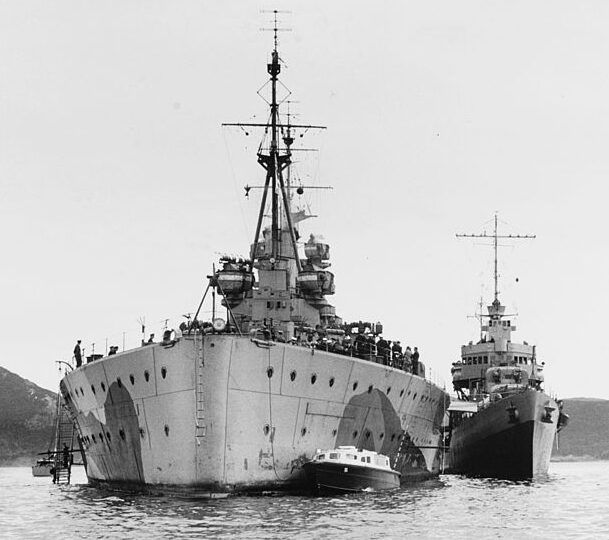
Next she was sent to convoy escort duty in the South Atlantic, operating from Cape Town in South Africa by December and was just arriving of Good Hope when informed of the Pearl Habor attack. Rushed back to Trinidad on 30 December she returned to her previous South American coast patrols on 18 January 1942. This went on until an overhaul at Charleston by July-August 1942, and stayed in the Caribbean, before being ordered to Panama on 31 August, corssing to be reassigned to the Southeast Pacific Force.
USS McDougal started with patrols off Pacific-coast Latin America on 7 September 1942 and for two years, until late 1944, the patrolled from Balboa in Panama Canal Zone and cruised from Nicaragua and the Magellan straits. She also ventured to the Galápagos, Juan Fernández Islands, stopping along ports in Ecuador, Peru, and Chile. She recorss the canal for the east coast and arrived in New York 4 September 1944. After crew’s rest and an overhaul she resumed escort duties on 12 September 1944, and reached UK while escorting convoy CU 39. For 6 months she made four more convoy escort missions and arrived in New York on 5 March 1945 with UC 57, goinf stright into overhaul.
She served with the Operational Development Force, Atlantic Fleet (TF 69) from Casco Bay until mid-September 1944 and was reclassified AG-126 on the 17th carrying out experimental operations including naval gunnery and radar. This went on for 1945 as well, and home ports such as Boston, Newport and Norfolk. In Boston by 15 December 1945 and Norfolk in March 1946, then New York on 15-16 June, decommissioned at Tompkinsville (Staten Island) on 24 June 1946. A TS for the Naval Reserve from 13 January 1947, under the 3d Naval District while (Brooklyn) she trained recruits until decommissioned a final time on 8 March 1949, sold for BU to H. H. Buncher Co. on 2 August, stricken on the 15th, and BU from September 1949.
 USS Winslow DD-359 (1936)
USS Winslow DD-359 (1936)
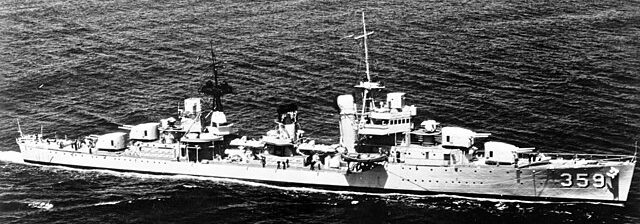
USS Winslow was commissioned at the Philadelphia Navy Yard on 17 February 1937 wuth Commander Irving R. Chambers in command. After outfitting in October she started her shakedown cruise to Europe. She passed her final acceptance trials off Maine and was reassigned to Battle Force Pacific. By Early 1938, she transited the Panama Canal to join DesRon 9 based in San Diego, California. For the next three years, she conducted operations in the eastern Pacific, between Hawaii and the west coast, homeported from San Diego.
In 1941, she was ordered back to the Atlantic and via Guantanamo Bay, Cuba, joined Norfolk. This summer was spent training with submarines off the east coast, and soon her first Neutrality patrols, with the pzarticular assignment of keeping an eye on interned Vichy French ships at Martinique and Guadeloupe (French Antilles, Carribean). By August she screen the heavy cruiser USS Tuscaloosa (CA-37) escoring USS Augusta with the President to the argentia conference with PM Chrchill in August (Atlantic Charter).
She was sent to Halifax by November made ready for Convoy WS-12X bound to Southeast Asia via the Cape of Good Hope and Singapore. She departed on 10 November and while off Cape Town in South Africa learned about the Pearl Harbor attack and state of war. She left Cape Town for home, placed under command of Vice Admiral Jonas H. Ingrain with the 4th Fleet tasked of South Atlantic neutrality patrols. She patrolled the narrowing part of the Atlantic between Brazil and Africa looking after both U-Boats and German blockade runners, until April 1944, making brief overhauls back in the US by June 1942 and October 1943 in Charleston.
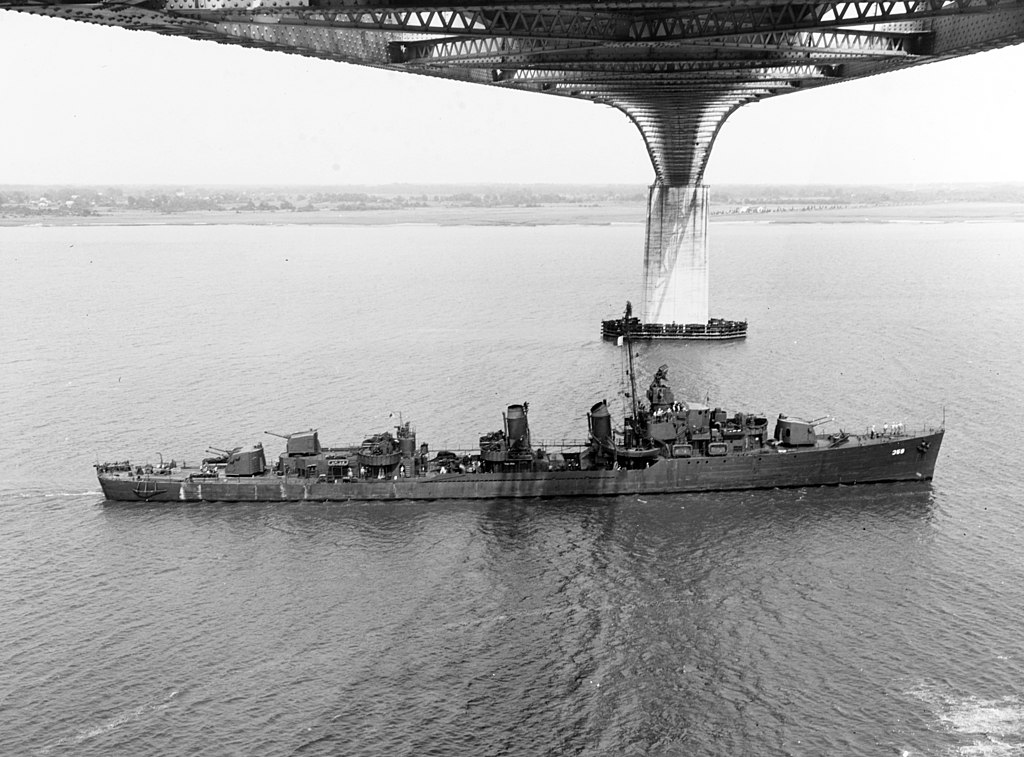
Passing under the Cooper River Bridge, Charleston, August 1945. Note her dark blue livery and rebuilt superstrtuctures. She was prepared for the Pacific but the war ended before she could get there.
From April 1944 she escorted warships from Boston via Norfolk to the West Indies. From August she escorted convoys from from New York to the British Isles and Ireland, five of them across the Atlantic. By March 1945 she was back in Charleston for her longest overhaul (4 month) and significant changes along the lines of USS Selfridge. She was prepared for the Pacific, and made a refreshed cruise off Maine, Casco Bay, but when ready to depart, the war was already over. She started like her sister USS McDougal a serie of experimental work, with AA ordnance and 17 September 1945, she became AG-127. She served with the Operational Development Force until decommissioned on 28 June 1950, placed in reserve (Charleston Group, Atlantic Reserve Fleet) and stricken on 5 December 1957, sold on 23 February 1959. She apparently won no battle star.
 Phelps DD-360 (1935)
Phelps DD-360 (1935)
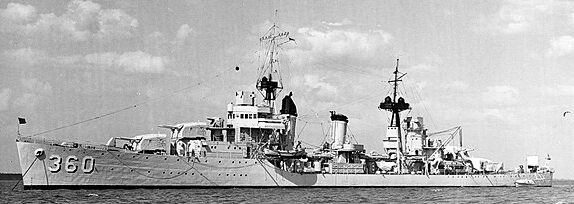
USS Phelps was commissioned on 26 February 1936 with Albert H. Rooks in command. From November 1936 she screen with USS Chester the cruiser USS Indianapolis carrying the President to Buenos Aires, for the Inter-American Peace Conference of 1936. She also made good-will visits to Montevideo and Rio de Janeiro, completing her shakedown cruise. The rest of her interwar service was standard, she served with the Atlantic Destroyer force, between drills and yearly Fleet Problems in 1937, 38, 39 and 1940.

USS Phelps off San Francisco, 11 December 1942.
On 7 December 1941, USS Phelps was present during the attack, shooting down one attacker. In February-March 1942, she was part of the destroyer screen for TF 11 (USS Lexington) which attacked Huon Gulf, Lae and Salamaua in New Guinea, as well as the Gulf of Papua on 10 March. She thus took part in the Battle of the Coral Sea on 8 May, Phelps being reassigned to USS Yorktown when both carriers spitted. She ermeged from the battle without casualties, but was ordered to join the crippled USS lexington and finish her off with two torpedoes.
By June 1942, she screen American carriers at the Battle of Midway. In August 1942, she covered the Invasion of Guadalcanal.
She retired to the west coast in October for an overhaul and crew’s rest and was back to participate tp the invasion of Attu in Alaska by May 1943. She covered operations, bombarding Kiska. Back home she was reassigned to operations against Makin atoll, providing on-demand fire during and after the landings, in November 1943. In February 1944 she took part in the Marshall Islands campaign, bombarding Kwajalein and Eniwetok. From March 1944 she was placed as close protection of the previous fleet oilers and did not saw the assault on the Palau Islands. In June 1944 she took part on the Battle of Saipan, shelling on-demand the beach and inland objectives.
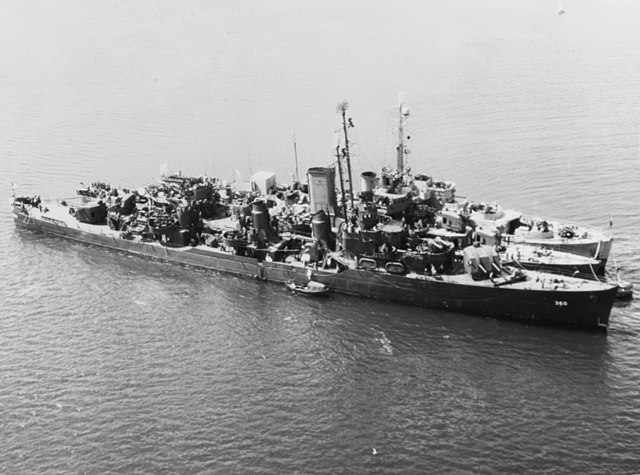
USS Phelps as rebuilt in August 1945, Casco Bay, Maine, alongside USS McCall.
After this, she was recalled for the Atlantic, steaming via the Panama Canal and entering Charleston harbor for her wartime major overhaul and reconstruction in August. In Novermber 1944 she reported for duty in Norfolk, escorting a convoy to Mers-el-Kebir in Algeria. She made four of such missions in all, and she was back in New York on 10 June. After the mayhem of the pacific campaign this was a quiet and uneventful service for the crew. She was decommissioned on 6 November 1945 in NYC, stricken on 28 January 1947 and sold for BU to Northern Metals Co. of Philadelphia. With twelve battle stars she remained the most decorated destroyer of the Porter class.
 Clark DD-361 (1935)
Clark DD-361 (1935)
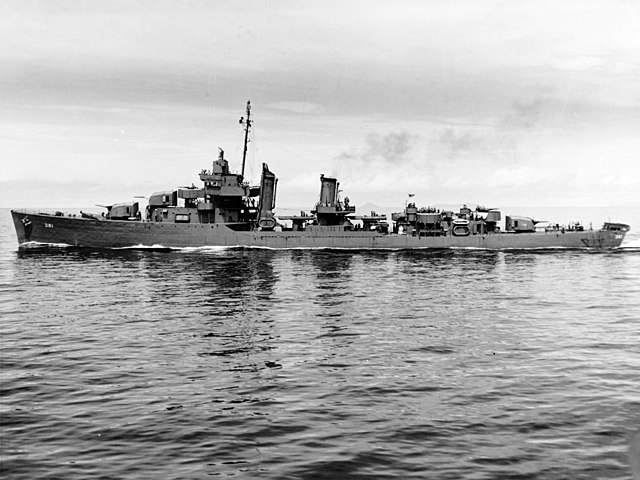
USS Clarke was commissioned 20 May 1936 with H. Thebaud as fist captain. After the usual shakedown and trials, she served on the Atlantic coast, in the and Caribbean alterating between the winter and summer, including fleet problems on the Pacific, at Pearl Harbor, her home port from 1 April 1940.
From 3 March to 10 April 1941, she was to Samoa, Australia, and Fiji, and was overhaul at San Diego until departing on 27 December to escorted two convoys to Pearl Harbor. next she was seen in ASW patrols off Pago Pago in Samoa. From February-March 1942 she joine the carrier task force for the operations in New Guinea
In April-May 1942, she escorted four convoys between Pearl Harbor and San Francisco and went to Midway. Back to San Diego and later Balboa, Panama, she joined another convoy bound for Wellington, in New Zealand.
From 12 August and until 8 September, she escorted a convoy to Nouméa, New Caledonia of oilers responsible to resupply the main task forces. She was back in Auckland and escorted furtherconvoys to South Pacific island bases. She was detached for ASW patrols off Nouméa, and on 11 December 1942 reported to Balboa as flagship for the Southeast Pacific Force.
Until 10 August 1944, she toured South American ports (west coast) and crossed Panama for her east coast overhaul. From 4 September 1944 and 11 April 1945 she was based on the east coast, safeguarding transatlantic convoys to France and the British Isles. She won 2 batltle stars for her WW2 service.
On 15 June 1945, she was back in Philadelphia, where she was decommissioned on 23 October 1945, solf for BU on 29 March 1946.
 Moffett DD-362 (1935)
Moffett DD-362 (1935)
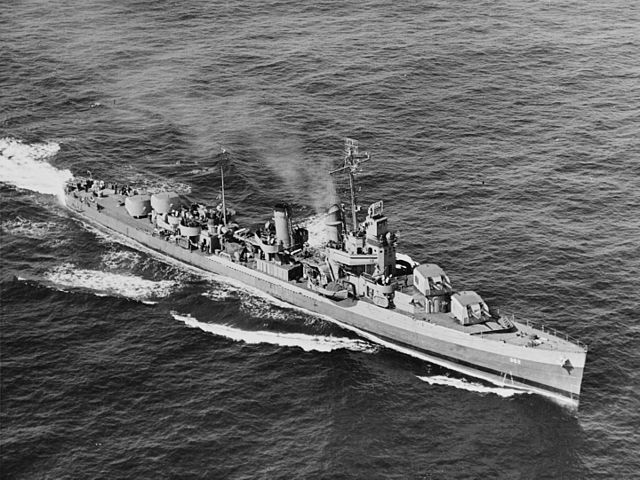
USS Moffett was commissioned at Boston, Massachusetts on 28 August 1936. Under command of Andrew H. Addoms she left Newport, Rhode Island, her first homeport after trials and shakedown cruise for a new base of Boston for the Atlantic Fleet. She operated there between 1936 and 1941 alternativing between seasons and locations. On 24 April 1941 she was part of the South Atlantic Neutrality Patrol off Brazil. Next she operated off Puerto Rico, guarding against possible hostile action by the admiral commanding the French West Indies fleet (Martinique-Guadeloupe).
In August 1941 she was detached to protect USS Augusta carrying President Roosevelt to the “Atlantic Charter Conference” off Newfoundland.
During her convoy escort she also visited West African ports and this service went on until 1943. On 17 May with USS Jouett she escorted another convoy in the Caribbean, when patrol planes spotted and reported an U-Boat. Both arrived on the sport at 12:46, and Moffett sighted U-128. She straddled her with gunfire, until unable to dive, the crew surrendered. They were nearly all picked up on deck, 50 survivors and the captain.
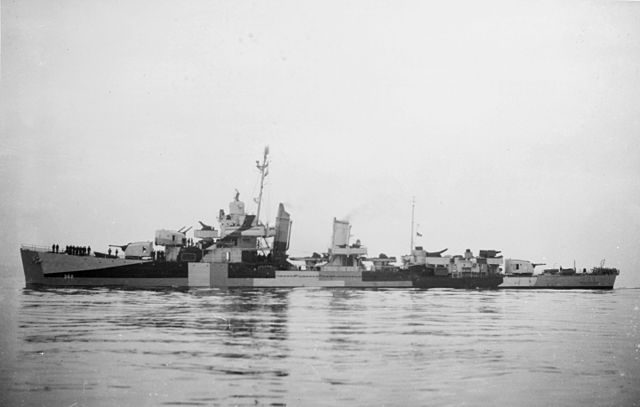
USS Moffett off Boston September 1944
In August 1943 she escorted USS Memphis and merchant ship to Ascension Island when sonar-picked U-604. The latter was chased by her and aircraft until the night, until she surfaced 95 miles north of Trinidad. Moffett arriaved and hit her five times while surfaced, but she dove again, and was picked up three days later thanks to airborne patrols. Sonar contact was regained and Moffette badly damaged her with depth charges. Eventually, the U-Boat surfaced and was scuttled by her crew on 11 August.
On 26 March 1944, Moffett escorted Convoy YN-78 to England, planned for the invasion of Normandy, stopping in Wales and Northern Ireland. She was back in NyC on 11 May.
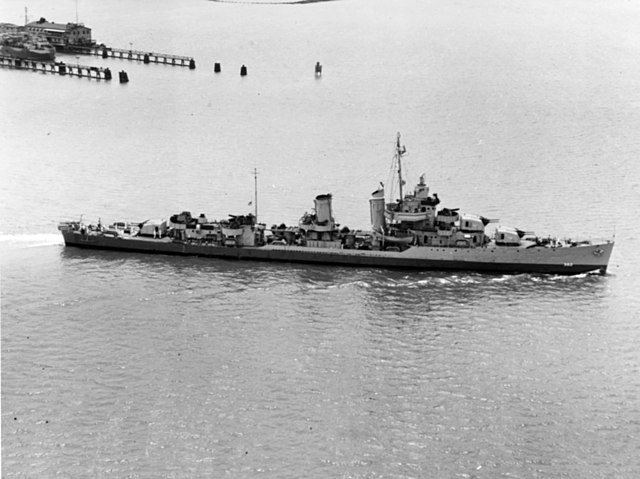
USS Moffett in Hampton Roads, 13 June 1944
On 1 August Convoy UGS-48 was air attacked by the axis while underway to Bizerte in Tunisia. The destroyer laid smoke in protection and manoeuvered brilliantly to dodge torpedoes in an attack that went up to the night, and of course shooting down some with antiaircraft fire. She was back to New York on 27 August and had an inactivity period, until her last escort missions, to Oran, in April 1945, followed by an overhaul in Boston. She was also sent for more in Charleston on 28 May and was still there in August, as the war stopped (and her ovehaul was suspended).
She was decommissioned instead of 2 November 1945, Reserve Fleet, stricken on 28 January 1947, sold on 16 May 1947. She received two battle stars.
 Balch DD-363 (1936)
Balch DD-363 (1936)
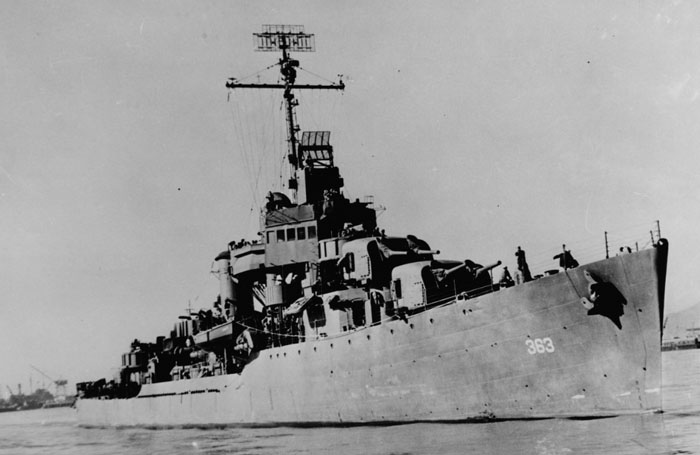
USS Balch Off San Francisco, California, following overhaul, 30 August 1943. Photograph from the Bureau of Ships Collection in the U.S. National Archives.
USS Balch was commissioned 20 October 1936. After her shakedown and initial training she served under the Chief of Naval Operations and departed Newport for the Pacific in October 1937, homeported to San Diego and DesDiv 7, Battle Force.
She became herself later flagship of DesRon 12 and later DesRon 6, taking part in various fleet Battle Problems, and cruises, various drilled in the Pacific but also returning to the Caribbean area. After Fleet Problem XXI at Pearl Harbor, she was sent to Mare Island Navy Yard of a short ovrhault until 1940. She made six cruises between Hawaii and the west coast, until December 1941.
Since 1st December she was part of Task Force 8, not in Pearl during the attack. She cruised in the Pacific and took part in the invasion of Tarawa in the Marshall Islands on 1 February 1942 (with bombardments).
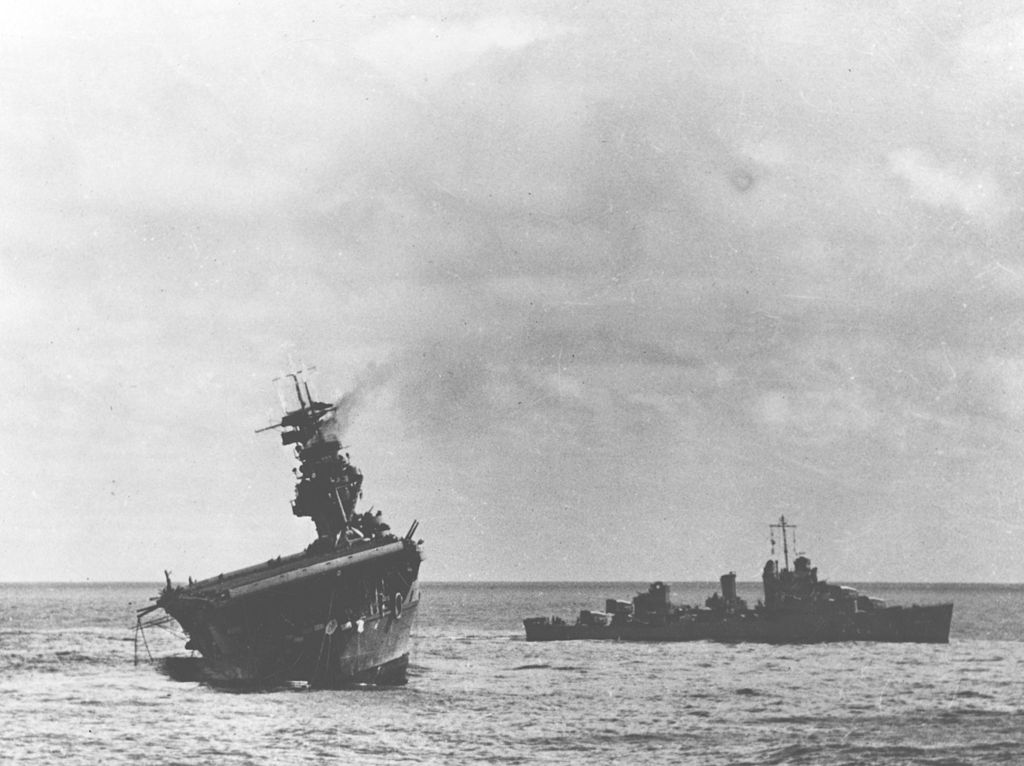
From February 1942 to June 1944, she was tasked with screening and ASW patrol as well as fire support for the invasion of Wake Island, Doolittle Raid on 18 April, but also the Battle of Midway -she rescued 545 survivors of the crippled USS Yorktown) as well as the Guadalcanal landings in August, the Attu invasion (11 May-2 June 1943); and the lesser known Toem-Wakde-Sarmi landings on 25–28 May 1944. She also took part in the Biak Island invasion from 28 May to 18 June.
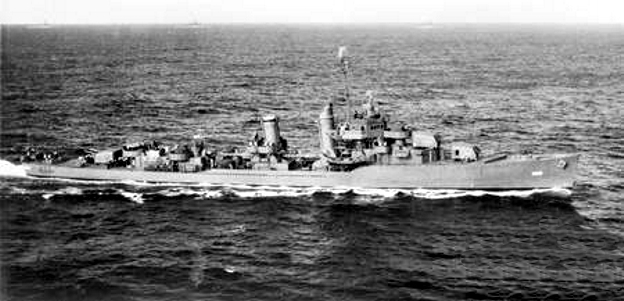
On 15 July 1944 she was back in NyC, reassigned to the Atlantic and making 5 rotation with Europe and the Mediterranean Between 2 August 1944 and 23 May 1945, notably visitin several North African ports. On 12 April 1945, Captain Alfred Lind took command and she ws reassigned to Task Group 60.11 until 8 May 1945, rescuing 46 survivors from SS Belgium on 14 April 1945. She was based in Oran, Algeria, and went home by June. She had earned 6 battle stars for her servive, the second most decorated of her class. On 16 June 1945, she commenced was inactivated Philadelphia, decommissioned on 19 October 1945 and sold for BU in 1946.

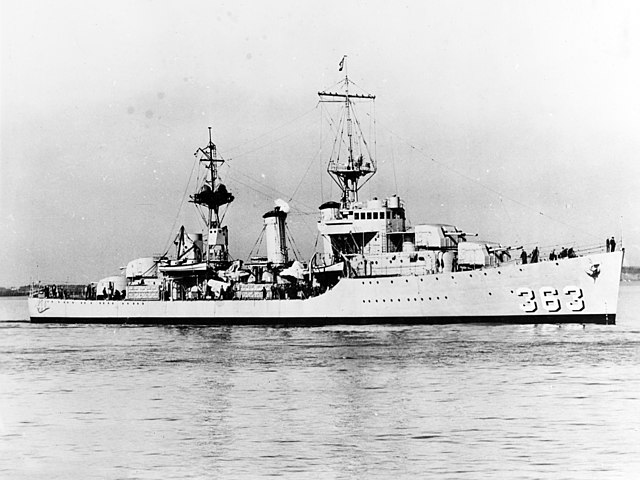
 Latest Facebook Entry -
Latest Facebook Entry -  X(Tweeter) Naval Encyclopedia's deck archive
X(Tweeter) Naval Encyclopedia's deck archive Instagram (@navalencyc)
Instagram (@navalencyc)





 French Navy
French Navy Royal Navy
Royal Navy Russian Navy
Russian Navy Armada Espanola
Armada Espanola Austrian Navy
Austrian Navy K.u.K. Kriegsmarine
K.u.K. Kriegsmarine Dansk Marine
Dansk Marine Nautiko Hellenon
Nautiko Hellenon Koninklije Marine 1870
Koninklije Marine 1870 Marinha do Brasil
Marinha do Brasil Osmanlı Donanması
Osmanlı Donanması Marina Do Peru
Marina Do Peru Marinha do Portugal
Marinha do Portugal Regia Marina 1870
Regia Marina 1870 Nihhon Kaigun 1870
Nihhon Kaigun 1870 Preußische Marine 1870
Preußische Marine 1870 Russkiy Flot 1870
Russkiy Flot 1870 Svenska marinen
Svenska marinen Søværnet
Søværnet Union Navy
Union Navy Confederate Navy
Confederate Navy Armada de Argentina
Armada de Argentina Imperial Chinese Navy
Imperial Chinese Navy Marinha do Portugal
Marinha do Portugal Mexico
Mexico Kaiserliche Marine
Kaiserliche Marine 1898 US Navy
1898 US Navy Sovietskiy Flot
Sovietskiy Flot Royal Canadian Navy
Royal Canadian Navy Royal Australian Navy
Royal Australian Navy RNZN Fleet
RNZN Fleet Chinese Navy 1937
Chinese Navy 1937 Kriegsmarine
Kriegsmarine Chilean Navy
Chilean Navy Danish Navy
Danish Navy Finnish Navy
Finnish Navy Hellenic Navy
Hellenic Navy Polish Navy
Polish Navy Romanian Navy
Romanian Navy Turkish Navy
Turkish Navy Royal Yugoslav Navy
Royal Yugoslav Navy Royal Thai Navy
Royal Thai Navy Minor Navies
Minor Navies Albania
Albania Austria
Austria Belgium
Belgium Columbia
Columbia Costa Rica
Costa Rica Cuba
Cuba Czechoslovakia
Czechoslovakia Dominican Republic
Dominican Republic Haiti
Haiti Hungary
Hungary Honduras
Honduras Estonia
Estonia Iceland
Iceland Eire
Eire Equador
Equador Iran
Iran Iraq
Iraq Latvia
Latvia Liberia
Liberia Lithuania
Lithuania Mandchukuo
Mandchukuo Morocco
Morocco Nicaragua
Nicaragua Persia
Persia San Salvador
San Salvador Sarawak
Sarawak Uruguay
Uruguay Venezuela
Venezuela Zanzibar
Zanzibar Warsaw Pact Navies
Warsaw Pact Navies Bulgaria
Bulgaria Hungary
Hungary

 Bundesmarine
Bundesmarine Dutch Navy
Dutch Navy Hellenic Navy
Hellenic Navy Marina Militare
Marina Militare Yugoslav Navy
Yugoslav Navy Chinese Navy
Chinese Navy Indian Navy
Indian Navy Indonesian Navy
Indonesian Navy JMSDF
JMSDF North Korean Navy
North Korean Navy Pakistani Navy
Pakistani Navy Philippines Navy
Philippines Navy ROKN
ROKN Rep. of Singapore Navy
Rep. of Singapore Navy Taiwanese Navy
Taiwanese Navy IDF Navy
IDF Navy Saudi Navy
Saudi Navy Royal New Zealand Navy
Royal New Zealand Navy Egyptian Navy
Egyptian Navy South African Navy
South African Navy






























 Ukrainian Navy
Ukrainian Navy dbodesign
dbodesign